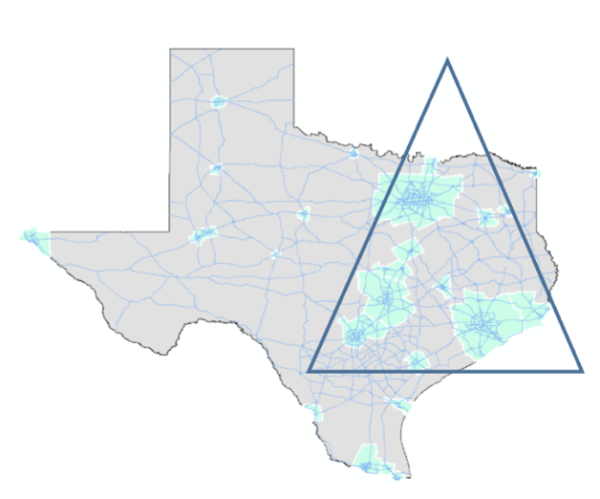What is a Megaregion?

The Cooperative Mobility for Competitive Megaregions (CM2) consortium was formed through a US Department of Transportation (USDOT) grant in January 2016. The Tier-1 USDOT grant established a University Transportation Center based at The University of Texas at Austin (UT Austin) for purposes of megaregional research.
But what exactly is a megaregion? Not only do they encompass multiple cities and counties, but many also include several states, all of which must work collectively to manage a competitive megaregion. Over the last two years, the consortium has worked to better define transportation challenges that exist within megaregions.
The fact is, there is no single definition of a megaregion. Lisa Loftus-Otway, research associate at the Center for Transportation Research (CTR) and her team at UT Austin observed this absence while reviewing statutory and regulatory documents. They noted that there needs to be definitional consistency for allocation and appropriation of funding as well as in policy components from the USDOT. Because the term has been defined differently, there are variations on what should be prioritized within megaregions across jurisdictions. When CM2 researchers from UT Austin, the University of Pennsylvania (UPenn), Texas Southern University (TSU), and Louisiana State University were asked about their definitions, they provided varied takes.
Loftus-Otway and Senior Research Scientist Robert Harrison at UT Austin view megaregions as highly populated regions that reflect powerful economic success and attract population growth either within a state or across state lines. Megaregions are not formally recognized in the hierarchy of governance structure like a city or metropolitan planning organization (MPO). And yet, they generate large sub-systems of production and consumption. These economic systems result in the movement of goods and people and impact modal logistics, industry location, urban housing, city services, and more. This makes them fascinating places to study!
Researchers also use different approaches to address megaregional challenges. Dr. Qisheng Pan, a professor of Urban Planning and Environmental Policy at TSU, researches freight operations in the Texas Triangle. His work focuses on developing a truck flow estimation model for freight by incorporating spatial integration of the Federal Highway Administration’s (FHWA) Freight Analysis Framework (FAF). Because megaregions include complex information and business networks, developing an analytical model for estimating truck flows will better determine efficiency of freight mobility in megaregions.
Megaregional issues are not limited to business and the economy. They also impact the residents that live within them. Dr. Junfeng Jiao, an assistant professor at UT Austin, researches the occurrence of transit deserts across megaregions. He analyzes where the need for public transportation does not meet the demand across the United States. He also notes that megaregions are home to "super commuters" that travel more than 50 to 90 miles to get to their place of work. The South Census Region (which includes Texas) had the highest percentage of long distance commuters at 3.1% in 2009.
Dr. Carol Lewis' and Dr. Gwendolyn Goodwin's research at the Center for Transportation, Training, and Research (CTTR) at TSU CM2 also studies the impacts of insufficient travel options on residents. They are developing a framework to determine purpose and need for increased travel options for people in rural communities and towns disconnected from urban areas.
Finally, megaregions are not limited to national borders. Dr. Eric Guerra of UPenn is researching megaregional ties between the United States and Mexico. Megaregions across international borders do hold a shared history and culture or regulatory power in the same way that national, metropolitan, state, and local entities do. International megaregions that are limited in power and differ widely in their identity make them difficult to define. Rather than partner across international megaregions, it is more efficient to collaborate with local and national governments across borders along specific topics and themes. Dr. Guerra is particularly interested to learn whether the Megaregion is a useful geographic entity when considering the relationship between travel behavior, household income, urban form, and transportation supply within and across the United States and Mexico.
Overall, planning in cross-jurisdictional megaregions can be susceptible to varying levels of regulations. This makes creating plans for megaregions surprisingly complex. Planning within megaregions requires creativity, flexibility, and an understanding of how inequity may result, when funds are distributed to certain areas within a megaregion. While it is difficult to maintain current revenues for our existing transportation network, re-imagining transportation on a megaregional scale will involve a massive commitment. Consensus building and a strong will at both the organizational and megaregional level is necessary to move toward a megaregional planning approach.
To learn more about the CM2 consortium’s work, please visit sites.utexas.edu/cm2.
Authored by Olivia Posner, Master of Science in Community and Regional Planning student and Graduate Research Assistant for the CM2 consoritum.

